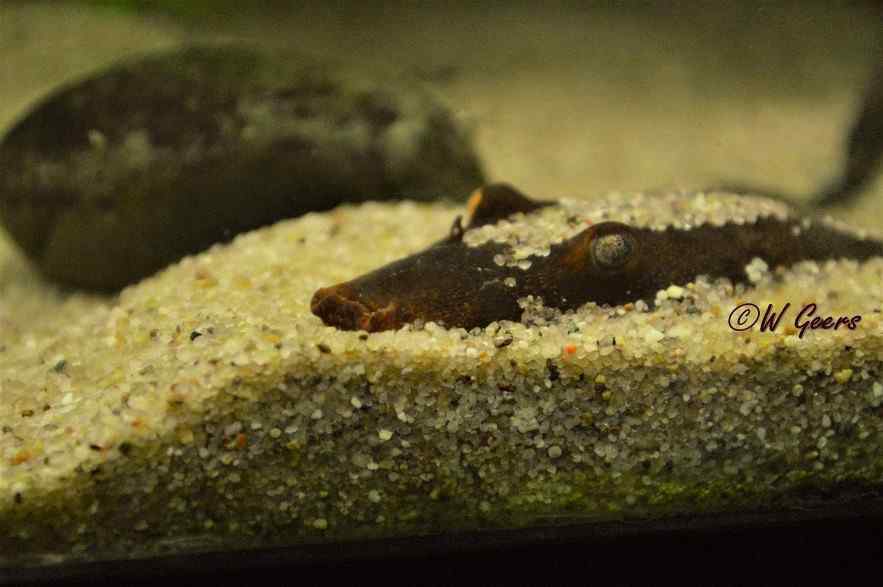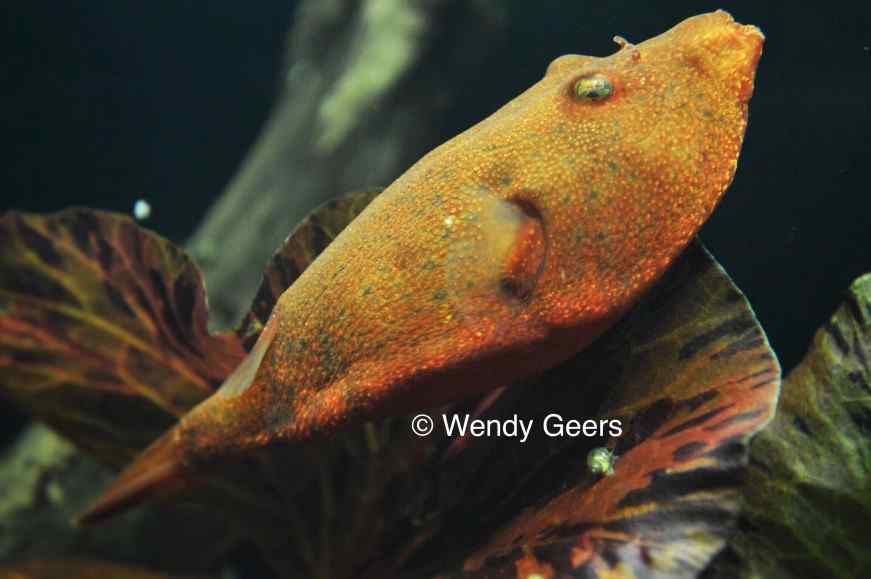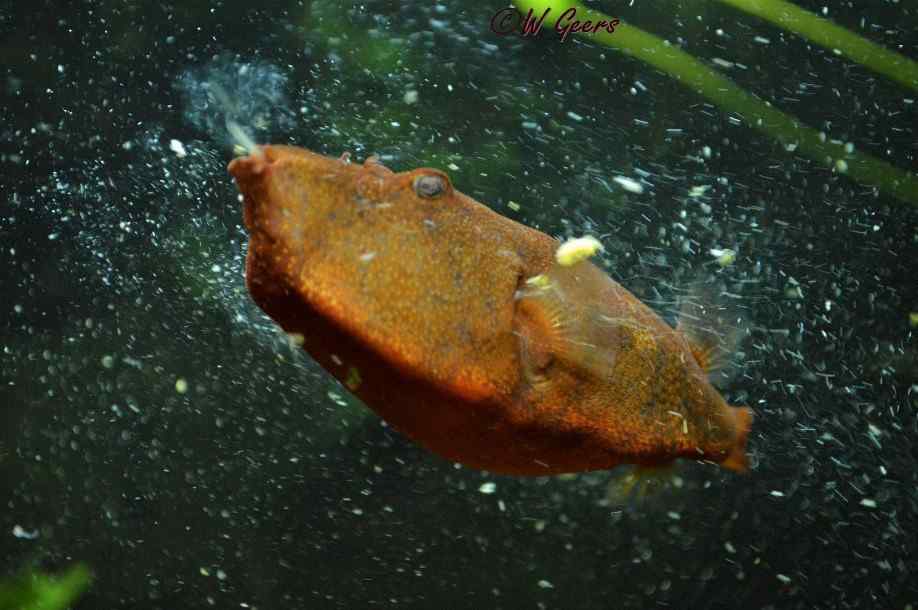Tetraodon miurus – Potato Puffer
Tetraodon miurus is an African freshwater puffer fish in the genus Tetraodon. They are also often referred to as Congo Puffer or Potato Puffer. The red variety, which is quite rare, is called Red Congo or Red Potato.
The scientific name was first validly published in 1902 by the Belgian zoologist and ichthyologist George Albert Boulanger. The species name miurus means ‘with small tail’.

Description
This puffer fish comes in a wide variety of colors. This can range from red, orange, brown, black, gray and marbled. The belly is usually white or a lighter shade of the base color. An irregular dot pattern can occur, but we almost never see this.

Tetraodon miurus also has anything but a ‘normal’ shape or appearance. The name ‘Potato’ has been unanimously discussed. We cannot ignore the fact that he just resembles a potato.
A notable anatomical adaptation of this species is that their mouths are pointed upwards. This is such that they can easily grab their prey without much effort.
Origin
The Congo Pufferfish is a medium-sized puffer fish native to Africa. They grow to a mature size of 15 centimetres.
They live in large parts of the Congo Basin and its tributaries. More specifically, this species will be found in the Kinsuka Rapids, the lower part of the Congo Basin, up to the higher Congo Basin in Lualaba. Thus, they are found both in large lakes and in fast-flowing waters.

Habitat
The natural habitat consists of clear water, fast flowing water with high oxygen levels. Tetraodon miurus is a bottom fish that burrows into the sandy bottom or ‘lurks’ between vegetation and stones. This means that they literally wait for prey to pass their nose and then bite from a stationary/buried position and devour it.
Character/Special Traits
The Potato Puffer is a real ambush predator. This is the smallest and most special group among the pufferfish.
Ambush predators, called lurkers, are lurking hunters. As mentioned before, they literally sit or lie waiting for prey to pass their nose and then bite out of nowhere.
Unlike other pufferfish, they lack the speed to swim after prey.
Buried in the sand with only their eyes visible, moving in all directions. Pufferfish can move both their eyes separately and thus have an extremely wide and good view.
It should be clear that ambush predators are inactive fish. They will lie still most of the time, whether in the bottom or not. However, there are exceptions where the Miurus shows more active behavior and likes to swim around in the tank.
The pufferfish that fall into the ambush predator group are the only pufferfish that are allowed to eat fish. Other freshwater puffers that do not belong to this group, such as open water hunters and stealth predators, are unable to digest this and will very quickly develop liver problems.

The lurking hunters are very aggressive fish. Both to conspecifics and other fish. They attack anything that comes in their line of sight. Anything moving is considered food.
The Potato Puffer is a master of camouflage. Their ability to adapt to the environment is many times greater than that of other pufferfish. They are actually chameleons. They often take on green and brown tones so that they do not stand out in the substrate, between stones or wood. Yet they can go beyond taking on natural colours. They can suddenly turn orange or red if the situation calls for it.

They don’t just camouflage themselves. They also discolour very quickly depending on their mood. When they don’t feel safe or uncomfortable, for whatever reason, they turn dark to grey/brown or even black. It is not at all strange if you see that your Tetraodon miurus suddenly changes colour. As you get to know your Potato Puffer, you will know which colours have which meaning. So don’t be scared right away.
The Aquarium
The aquarium should have a sandy bottom. This is essential. Filter sand 0.4-0.8 mm grain is the perfect substrate. Gravel or stones with sharp edges is a real no-go. The thickness of the layer should be such that they can completely dig in until only their eyes are visible. Often this means a slightly thicker layer on the front of the aquarium than we are used to. Use at least 8 centimetres for an adult Tetraodon miurus.
Furthermore, shelters must be created by means of wood covered with plants. Epiphytes such as Anubias, Java fern, Bolbitis are very suitable. This in combination with sufficient open space where they can bury themselves at all times.
Plants in the soil are not recommended as this species will loosen everything or damage the roots to such an extent that the plant will still be considered lost.
Aquarium size and water parameters
Given the behaviour of this pufferfish, the height of the aquarium is of less importance. However, it should not be less than 30 cm. For 1 specimen, the minimum size is 80x40x30 centimetres, where 80x40x40 centimetres is a standard size, which corresponds to approximately 100 litres gross. Bigger is always good.
A larger aquarium does not lead to the possibility of adding an extra Potato Puffer. This pufferfish should be kept solitary.
Water parameters
– Ph 6,5 – 7,5
– Temp 25 – 26.5 degrees Celsius(average better at a bit warmer, 26 is certainly allowed)
– No2 0
– NH3/4 0
– NO3 < 15 ppm
– GH 4 – 15
Tank mates
Due to the typical character of the fish, other inhabitants are not possible at all. Neither conspecifics nor other fish. They attack everything and see everything as food.
Sexing
To date, no gender distinction can be seen with the naked eye.
Diet
A varied and balanced diet is very important to provide them with all the necessary nutrients.
Tetraodon miurus is a fish-eating pufferfish. However, this does not mean that you should feed them fish every day. It also eats shrimp, small crustaceans (freshwater), worms and insects.
Recommended nutrition
- Fish free from thiaminase
- Dendrobena
- Cockroaches
- Crickets, grasshoppers,
- (Frozen) shrimp
- Lobsters
In the wild, Tetraodon miurus finds a whole range of food. That is why we have to respond to this in order to keep the health of the fish optimal.
Feeder fish that are thiaminase free are usually larger species such as Tilapia and American lake trout. You buy these and usually have to fillet them yourself. This can be placed in the freezer per portion and can be thawed at any time.
Worms, which they eat a lot in the wild can be ordered from any lfs. Fishing stores also have this in stock.
Do not feed your Potato Puffer mussel, cockle, oyster or other crustaceans!
The teeth of the Miurus are not very sensitive to overgrowth. It is rare that these need to be trimmed with a correct diet.
Tetraodon miurus is known to be a very picky eater! You really have to teach them to accept a new food. This is not without a struggle! If they don’t accept the food, try again later. This can take days, even weeks. In the meantime, don’t give them anything to eat. A pufferfish will not starve. Persevere!
Food ratio:
– 40% fish/shrimp
– 60% insects
Filtering
Because pufferfish are very sensitive to poor water quality, high biological and mechanical filtering is necessary. A filter must be able to filter at least 3x the volume of the tank per hour. More is always better.
A consistent refreshment policy is important to keep your nitrate levels under control. It should not exceed 15 ppm.
A consistent refreshment policy is important to keep your nitrate levels under control. It should not exceed 15 ppm.

How old can the Potato Puffer get?
Under ‘ideal conditions’ Tetraodon miurus can reach an age of 10 years. However, the expected lifespan has not yet been scientifically determined. It could be higher than 10 years. In the hobby, the oldest Miurus is estimated to be 10 years and 2 months in possession. The current age is slightly higher.
Video
Author
Wendy Geers – Want to discuss puffers or questions? visit: Facebook Kogelvissen zoet brak zout
Copyright images









Reviews
There are no reviews yet.